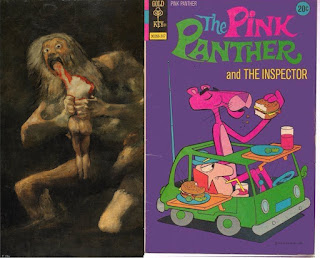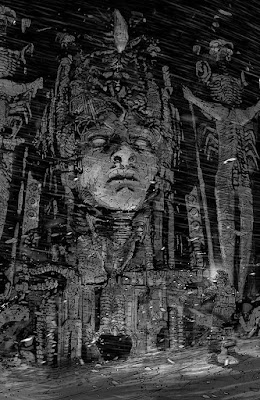leading from
a) A plan for a graphic novel that could even have become a novel
Tristan Jones thought about doing another Alien graphic novel series called Alien: Desolation before Dark Horse had their licence yanked and it was handed over to Marvel.
He was asked to pitch it to Titan as a novel but didn't go through with it.
- Tristan Jones: Cleaning
up notes for original projects going into the new year and saw this.
Figured I'd put the nail in the alien coffin and throw it out there as a
fun "what if". Was asked to pitch Desolation as a novel, but like the
Godzilla OGN, I'm pretty done with licensed publishing... ( Twitter: Dec 19 2022)
- Tristan Jones Hahah!
Thanks. Again, it’s broad stroke stuff — there’s a whole coke war and
conflict zone but showing marines in proper military engagements and law
enforcement and tonnes of other shit I’ve repurposed.(Twitter: Dec 19, 2022)
Tristan Jones: Hahahah! It could've been fun, but even looking over the notes and everything for the repurposing of it all into a novel, the landscape's changed so much in such a short space of time against the creators that I'm kinda like "yeah, nah... maybe as a video game or something"(
Twitter: Dec 19, 2022)
b) Intentions
His key idea for Alien:Desolation was to as it were interrogate the Alien films and bring the story back to what made Alien work in that it was so bafflingly alien.
There would have been no insect caste system.
It would also reduce as well as expand the Engineers and Weylan(d)-Yutani's involvement.
He wanted to get away from the series tropes as well as post new quesions
- Tristan Jones: Anyway,
key thing to Alien: Desolation was to interrogate the Alien films and
bring it right back to what made Alien work (that it was so bafflingly
alien). No insect caste system, reduce (AND expand) Engineers and WY
involvement. Get away from series tropes; pose new questions. (Twitter: Dec 19th, 2022)
c) The story's "villain"
The villain is a rogue biologist who basically points out he ridiculousness of trying to weaponise the alien. Essentially points back all the problems back to the derelict alien ship on the planetoid labled as LV-426 , with Prometheus, Alien: Covenant with the disappearance of its colony mission and a couple of other research missions between movies and Alien: Isolation.
- Tristan Jones: Villain is rogue biologist who basically points out the ridiculousness of trying to weaponise the alien. Essentially points back all problems back to the derelict alien ship
on the planetoid labled as LV-426 , with Prometheus, Covenant
and a couple of other research missions between movies and Alien:
Isolation. (Alien Desolation notes)
- Tristan Jones: Looks at Covenant xolony mission disappearing (Alien Desolation notes)
d) The return and death of Amanda Ripley
d.i) Roping Amanda back in
The idea was that Amanda Ripley who is supposed to be Ripley's daughter
in the extended Alien universe is roped back into the story
The
story would have found her hiding on Earth after Alien:Isolation with
severe PTSD and so a significant chunk of the story would have been set
in a Blade-Runner esque Beijing
She potentially overshoots her mother's death in Alien 3 because of time loss involved in regular hypersleep and FTL travel
d.ii) How she dies
Sventually sufforcates on LV-426 as back end to Aliens.
It would have been literally her last gasp at stopping what she
understood to be "the alien", wherein the company would keep coming for
it.
So she would essentially destroy her own ship (like her mother) to kill
the "ubermorph" after the first attempt (blow the derelict) fails.
It
was something he was potentially playing with depending on variables in
writing. Either way, Amanda would die the same way.
He wasn't planning on
playing by "continuity" outside of Isolation, Alien, Covenant and
Prometheus.
Everything after is speculative or inconsequential.
- Tristan Jones: Amanda
suffocating's pretty literally her last gasp at stopping what she
understood to be "the alien", wherein the company would keep coming for
it, so she essentially to destroys her own ship (like her mum) to kill
the ubermorph after the first attempt (blow the derelict) fails. (Twitter: Dec 19th 2022)
- backintime84
:Ahh, okay i can see how that works and ties back to nostromo
destruction & Ellen’s sacrifice on Fury 161. Would her attempt at
blowing the derelict be the reason for the huge crack in the derelict
seen in “Aliens,” where the Jordan’s came in? Thanx for your reply btw? (Twitter: Dec 19th 2022)
- Tristan Jones:
Sort of -- there'd be kind of a double ending where it connects Burke
to Ripley uncovering what he can of the Prometheus mission which leads
to the Nostromo landing, but the tracks have been wiped by others in the
past to cover up Prometheus/Covenant/Nostromo/Sevastopol (Twitter: Dec 19 2022)
Alexander Sison: Oh this looks pretty sick. Just to clarify though, so you put in the whole Amanda Ripley overshoots the Alien 3 ending in case they didn't accept the Amanda Ripley suffocates prior to Aliens ending? Or did it happen in response to editorial feedback?(Twitter: Dec 20 2022) Tristan Jones: It
was something I was potentially playing with depending on variables in
writing. Either way, Amanda would die the same way. I wasn't planning on
playing by "continuity" outside of Isolation, Alien, Covenant and
Prometheus. Everything after is speculative or inconsequential. (Twitter: Dec 20th, 2022)
e) Aliens, space jockeys and engineers
e.i) Space Jockeys
The space jockey would have been another alien, as a kind of what he referrd to as a proto-engineer. It would have been different to the ones in Prometheus and Alien: Covenant, but also much older. Then it would probably have been the opposite of the Engineers from Prometheus as far his intent went.
e.ii) Ubermorph
On a derelict ship elsewhere in the story, a Space Jockey gives birth to a type of Alien that he labels to as an "Ubermorph" (rather than an "Ultramorph" which Carlos Huante imagined being the creature chestbirthed by the Engineers from Prometheus) (See:
Prometheus: The Ultramorph)
e. iii) Engineers
He would have included in the story two engineers as seen in Prometheus who were some sort of religious extremists who were not responsible for creating the alien 'xenomorphs', and turn out to be genetic offshoots
e. iv) Black goo
His idea about the black substance would be that it was derived from the aliens
It was the same substance that they used to cocoon as well as adapt/evolve themselves
e. v) The alien species
He would have a bigger focus on making aliens in general significantly rarer again.
Space was big, empty and depressingly inhospitable
They never find the alien's homeworld.
In this story, the aliens don't spread like they always seem to in the comics, but of course the threat of the pathogen is getting closer to Earth
- Tristan Jones: Prometheus engineers are religious extremists - also genetic offshots of "prime" engineers (bigger) (Alien Desolation notes)
- Tristan Jones: Only creatures are a couple of Engineers (who you find aren't responsible for xenos and Ubermorph born from Space Jockey (trapped on derelict elsewhere) (Alien Desolation notes)
- Tristan Jones: Prometheus slim is derived from aliens, same substance they use to cocoon and adapt/evolve themselves. (Alien Desolation notes)
Tristan Jones: bigger focus on making aliens in general significantly rarer again. Space is big, empty and depressingly inhospitable. They never find the alien "homeworld". aliens/haven't/won't spread like they always seem to in
comics, but threat of the "pathogen" is getting closer to here. (Alien Desolation notes)
f) The alien queen
The alien queen here would turn out to be a one off mutation as as one of the X-generation of David's "bug hybrid" aliens experiments as seen in Alien:Covenant
- Tristan Jones:
Jockey would've been another alien. Kind of a proto-engineer.
Different
race to the ones in Prometheus and Covenant and much older. Probably
the opposite of the Prometheus ones as far as intent went.
The queen was just the X-generation offspring of David's "bug hybrid"
aliens. (Twitter: Dec 20th 2022)
- Tristan Jones: Queen in Aliens is a one-off mutation. David's fucking around in the Covenant is responsible (Alien Desolation notes)
g) David the android
He was pretty much dead set on making sure that David knew he wasn't ever going to be able to as it were 'ascend'.
David, if not as a robot, then as AI, would potentially return briefly>
But Tristans's idea if that he would have been reduced to a robot with the limitations that he hated.
His own creation would have turned on him
- Tristan Jones: I
was pretty deadset on making sure David knew he wasn't ever going to be
able to "ascend", and to give the pathogen some rules which it didn't
seem to have. David would've been reduced to a robot with limitations
like he hated -- again, hubris -- his own creation turning on him. (Twitter: 20th December 2022)
- Tristan Jones: David AI (if not robot) potentially returns briefly (Alien Desolation notes)

%3F309649551_10228871317387146_2772117858305024808_n.jpg)







































